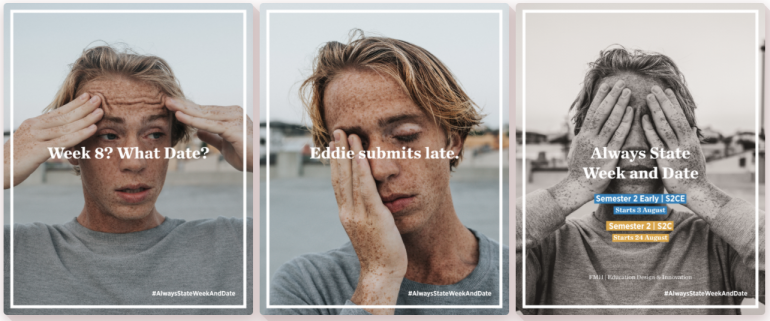Comments shared by students in the semester 1 USS, and presented as a qualitative topic–model analysis at this year’s Symposium by Jess Frawley and Sam Clarke, highlighted something that we know well: students value clear communication and clear expectations. By way of the USS survey, students have provided indisputable feedback. Clearly explained content, clear weekly structure and clearly structured online teaching were amongst the best aspects of their experience. Equally, students frequently shared that hard to follow structure, lack of clarity (especially in assignments), and too much content were aspects that needed the most improvement. It is important to be reminded of these issues and to consider the practical changes that you can make to improve communication and set clear expectations when you publish learning materials in your Canvas site.
Publishers know that a clear message is essential. In research publications we aim for a concise and persuasive abstract as we know that the abstract is the tool to communicate your research succinctly while highlighting its most important facets. News publishers, such as the BBC, know that a clear message is essential. The BBC style guide is an iconic document provided to ensure consistency and because, as we know too well, typos and blunders make great headlines. To help Canvas publishers of learning materials we have developed a short style guide to help you keep your resources and Canvas site clear and consistent.
This post was contributed by Catherine Walsh, Tina Barclay and Andrew Carfax-Foster, Education Design Team in the Faculty of Medicine and Health.
1. Always state week and date
Semester 2 2020 is quite unique in our university’s history, not least of which, the university is running two concurrent semester 2 sessions. On the face of it, two semesters is a simple solution to an organisational issue. However, from the student’s point of view this may provide an extra layer of complexity and confusion. We have two week 5s, two final exam periods, and extra intensive sessions. There is an easy way to bring clarity; simply always state week and date. Always.
When presenting lectures, when typing due dates in documents and when producing lecture slides specify both the week and the date. Time management and planning are essential skills for student success. You can help reduce trip hazards for students by simply always stating week and date in every document you publish.
2. Use the calendar to improve planning and prioritising
With more online activities now that students are not often on campus it is helpful to provide clear alerts to online activities. We want students to be able to easily understand the requirements of the course so we need to communicate clear expectations.
Canvas is clever. It generates calendar items and the to do list for you and your students whenever you set a date using the calendar form in the text box. Every place a date is used in your Canvas site, as an Assignment, Discussion Board, Quiz or Zoom tutorial, a calendar item is generated.
You can also add additional calendar reminders, to help students plan their learning and organise themselves.
When you use the calendar text box to add a date the dates also appear in the To Do List, Syllabus page and, for assessments, the Marks page.
3. Use Canvas modules for site integrity and cohesion.
Canvas is a publication and a well-designed publication needs a clear structure, an index or table of contents.
The organising principle for your course structure is Modules, in which you make pages and show the course progression for students. Modules are used to organize course content by weeks, units, or a different organizational structure. “Modules essentially create a one-directional linear flow of what students should do in a course.”
Think of modules as providing a cohesive architecture that benefits student-centred learning. Cohesion also suggests that students feel they belong together as a group with mutual dependence in the community of their unit of study, which is housed in your Canvas site. We want students to navigate easily in a space they feel is their community.
Practical tip: Make sure modules are visible to students in your course menu, add new pages, assignments, discussion and other learning content to the modules as you publish them. Plan this page as a linear table of contents and keep it up to date.
4. Use headings to chunk
Even if you didn’t read this article, you probably still read the heading above this sentence. The heading is an example of a UX (user-experience web design) chunking strategy.
In general usage, a ‘chunk’ means a piece or part of something larger. In the field of cognitive psychology, a chunk is an organizational unit in memory. According to cognitive load theory people have a limited capacity to process new content at a given time. We process our thinking about new information in our working memory before we reinforce it and shift it to long term memory. Chunking of new information is a strategy you can use in your classroom to help students remember and learn.
In the field of user-experience design, ‘chunking’ usually refers to breaking up content into small, distinct units of information. In your Canvas site you can use UX strategies used by web designers to chunk content and get a reader’s attention:
- Short lines of text
- Headings and subheadings
- Summary paragraphs for longer sections of text
- Highlight key words and groups of words (bold, italic)
- Numbered and bullet point lists
We want students to spend their capacity for learning on the content of the unit of study and applying what they have learnt. We don’t want students to waste their capacity for learning on trying to navigate your unit site, so we aim for page content that is easy to skim read, comprehend and remember.
5. Say it once, say it well, and link
A core principle of good design is: Say it once, say it well, and link. This principle reduces duplication and lowers the risk of publishing similar information on different pages, so students don’t know which is the source of truth.
Students have given us feedback that a lack of clarity, especially in assignments, is an important area that needs to improve.
We have found that it is common for a single assignment to be described in multiple places in a Canvas site: an announcement, the assignment dropbox page, as well as a Canvas page that summarises all the unit of study assessments for the unit. This provide at least three sources of information about the assignment.
A better strategy is to use only the Assignments page. Use the instruction field for that assignment to provide all information about the assignment. If you need to update information about the assignment, make the change there. When making announcements about the assignment provide a link to the assignment in the announcement, and maintain one source of truth. In any page in your site you can insert links to Assignments, Discussions, Pages, Quizzes, or any page in your navigational tool bar.
6. You need a proofreader
You wouldn‘t publish an academic paper without deciding on your structure, checking your references and asking someone to proofread. The same applies to your Canvas site. Everyone makes typos. Even Pulitzer prize winners have editors and proofreaders. It’s a good idea to ask someone to check your Canvas site.
It is important to also check your hyperlinks. These are the links to content either within your site or outside the unit site. Canvas has some neat features to help you here. In Settings on your navigational tool bar you’ll find the button to Validate Links in Content which will find your broken links so you can either delete or update them. And be careful to avoid underlining text which is not a hyperlink.
The BBC guide style guide explains that “Our use, or perceived misuse, of English produces a greater response from our audiences than anything else. It is in nobody’s interest to confuse, annoy, dismay, alienate or exasperate them.”
The various pages and features work together to make a consistent whole course for your students. Each page or feature in Canvas can contribute to the students’ experience and the learning outcomes for the whole course.






1 Comment